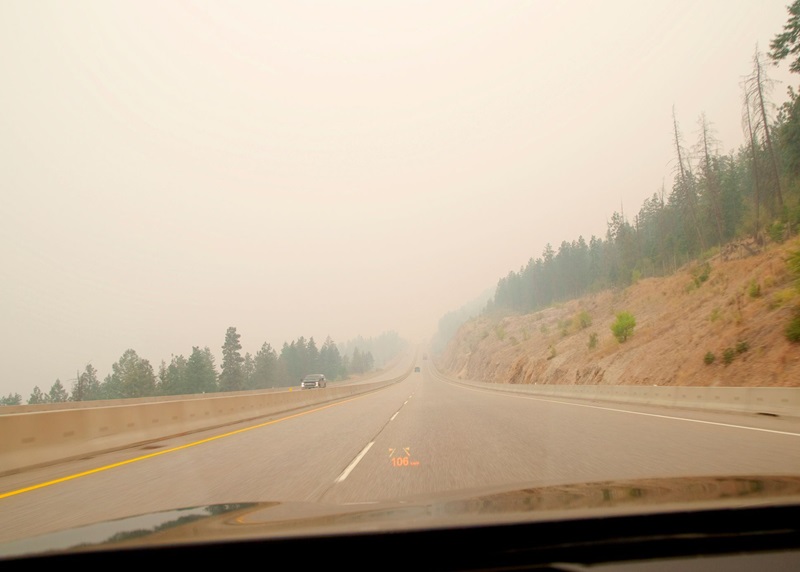B.C. city reports on AI wildfire early detection system

VERNON, B.C. – Vernon Fire Chief David Lind likens the Interior B.C. city’s new artificial-intelligence-driven wildfire detection system to a fire alarm in the forest.
The system involves cameras and scores of air sensors scattered among trees and other high points, collecting data that is fed into an AI system for analysis.
Its creator, Vancouver-based tech firm SenseNet, says it warns firefighters when it detects a pattern indicative of ignition and allows for a response within minutes instead of an hour or more when using traditional visual detection.
“It’s an exciting technology in that it’s really applying almost that fire-alarm system that we see in large buildings, where you’ve got every section of the building covered by some type of a monitor feeding back into a system that provides early notification to everyone … and almost taking that and applying it in an outdoors setting,” Lind said.
“If a fire occurs in the right area and there’s not a lot of eyes on it … it can delay detection,” he said. “As we start hitting these temperatures that are up above 30 degrees and our humidity is dropping down below 30 (per cent), fire can spread really, really quickly. In those conditions, it’s super important to get early detection.”
Fire Rescue Services in Vernon, about 400 kilometres northeast of Vancouver, have been testing the system for the past two years.
Lind says the city will take over care and control of about 150 sensors as the research trial period ends on Aug. 1. The nearby Predator Ridge Resort has also paid to install 100 more SenseNet sensors to feed into the AI detection system.
SenseNet says the sensors monitor the air for volatile organic compounds — or chemicals commonly found in the air — particulate matter, carbon monoxide, methane and nitrogen oxides along with thermal imaging, which can pick up smouldering fires not visible to the naked eye.
A SenseNet video shows devices about the size of cereal boxes being strapped to trees. It says the sensors detect the invisible gases from an ignition, before the AI algorithm finds the location. The video says it can do so less than a minute after ignition of a fire more than a kilometre from the sensors.
Valuable tool
Lind says the early detection has been a valuable tool for firefighters during testing, with the need for crews to get to wildfires faster as drought conditions prompt rapid growth of undetected blazes.
Last year’s wildfire season was the most destructive in B.C. history, burning more than 28,000 square kilometres of land and forcing thousands of people to evacuate communities in the Okanagan and the Shuswap.
Drought persisted through winter for several parts of the province, and a heat wave and lightning storms in Western Canada saw the number of active wildfires in B.C. increase sharply to about 150 over the past week.
At Predator Ridge, the SenseNet system was hoped to help draw tourists back to the Okanagan after severe blazes in recent years.
“This region in general, we’re all feeling it in terms of traffic to this region this summer,” says Predator Ridge senior vice-president Brad Pelletier.
“And a lot of it’s been impacted in terms of the pattern of booking due to fire. So, the more we strengthen our plans and … continue to reinforce that we’re committed to the safety of our guests and residents, the more we can overcome some of those challenges.”
The cost of the system’s installation at Predator Ridge has not been released, but Pelletier says the investment was “substantial” after initial testing proved positive.
“For us, it became a point where it was clear that this was leading-edge technology and could provide us with another layer of safety here at Predator Ridge, probably the most important layer of safety,” Pelletier said.
“There’s a constant reminder every year here as it gets dry, so I think everyone’s alert to the risk factor. And I think everyone is looking at what measures can be taken to prevent against the next large fire like what happened in West Kelowna,” he said, referring to a fire that swept down on that community in mid-August last year.
Lind said the new system was not meant to replace any existing detection systems but to provide “another layer” of protection while work continues on reducing fire fuel and other initiatives.
“There’s so much we can do,” he said. “We can make a really big difference, and so this is one project, one aspect that’s super positive, and those other components are really important as well.”
Lind said he had talked to other fire chiefs in B.C. about Vernon’s experiences with the AI detection technology. More sensors elsewhere could form the foundations of regional wildfire early detection, he said.
“The one aspect that the public really should keep top-of-mind is that this is another tool,” Lind says. “It’s not replacing all the existing tools, so if a person was to see smoke on their horizon, they absolutely should call 911.”
— By Chuck Chiang in Vancouver
Feature image by iStock.com/Lightguard







